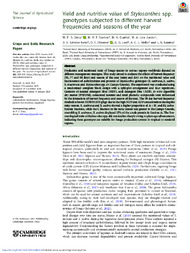Yield and nutritive value of Stylosanthes spp. genotypes subjected to different harvest frequencies and seasons of the year.
Yield and nutritive value of Stylosanthes spp. genotypes subjected to different harvest frequencies and seasons of the year.
Author(s): DINIZ, W. P. S.; SANTOS, M. V. F.; CUNHA, M. V.; LIRA JUNIOR, M. A.; SIMÕES NETO, D. E.; OLIVEIRA, O. F.; ARAUJO, G. G. L. de; MELLO, A. C. L.; SANTOS, L. S.
Summary: Productive and nutritional traits of forage species in various regions worldwide depend on different management strategies. This study aimed to evaluate the effects of harvest frequency (56, 77 and 98 days) and season of the year (rainy and dry) on the nutritional value and fractionation of carbohydrates and proteins of Stylosanthes genotypes (S. seabrana, S. scabra, S. mucronata and Stylosanthes spp. cv. Campo Grande). The experiment was conducted using a randomized complete block design with a split-plot arrangement and four repetitions. Contents of neutral detergent fibre (NDF), acid detergent fibre (ADF), in vitro digestible dry matter (IVDDM), condensed tannins and total phenolic compounds were influenced by the interaction of harvest frequency and season of the year. The 98-day harvest frequency resulted in lower IVDDM (579 g/kg) due to the high NDF and ADF concentrations during the rainy season. S. seabrana and S. scabra showed a higher proportion of A + B1 and B2 carbo- hydrate fractions, while the C fraction in the rainy season was greater in the Campo Grande, resembling S. seabrana. S. scabra displayed 15% of the crude protein in fraction A. The bromatological traits of Stylosanthes spp. did not decline sharply owing to plant age advancement, indicating these genotypes are suitable for forage production systems in tropical or semiarid regions.
Publication year: 2024
Types of publication: Journal article
Unit: Embrapa Semi-arid Region
Observation
Some of Embrapa's publications are published as ePub files. To read them, use or download one of the following free software options to your computer or mobile device. Android: Google Play Books; IOS: iBooks; Windows and Linux: Calibre.
Access other publications
Access the Agricultural Research Database (BDPA) to consult Embrapa's full library collection and records.
Visit Embrapa Bookstore to purchase books and other publications sold by Embrapa.

